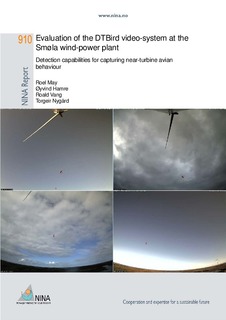Evaluation of the DTBird video-system at the Smøla wind-power plant. Detection capabilities for capturing near-turbine avian behaviour
Research report
Published version

View/
Date
2012Metadata
Show full item recordCollections
- NINA Rapport/NINA Report [2341]
- Publikasjoner fra CRIStin - NINA [2364]
Abstract
May, R., Hamre, Ø., Vang, R. & Nygård, T. 2012. Evaluation of the DTBird video-system at the
Smøla wind-power plant. Detection capabilities for capturing near-turbine avian behaviour.
NINA Report 910. 27 pp.
Collisions between birds and wind turbines can be a problem at wind-power plants both on-shore and offshore, and the presence of endangered bird species or proximity to key functional bird areas can have a major impact on the choice of site or location of wind turbines. There is international consensus that one of the main challenges in the development of measures to reduce bird collisions is the lack of good methods for assessment of the efficacy of interventions. In order to be better able to assess the efficacy of mortality-reducing measures Statkraft wishes to find a system that can be operated under Norwegian conditions and that renders objective and quantitative information on collisions and near-flying birds. DTBird developed by Liquen Consultoría Ambiental S.L. is such a system, which is based on video-recording bird flights near turbines during the daylight period (light levels >200 lux). DTBird is a self-working system developed to detect flying birds and to take programmed actions (i.e. warning, dissuasion, collision registration, and turbine stop control) linked to real-time bird detection. This re-port evaluates how well the DTBird system is able to detect birds in the vicinity of a wind turbine, and assess to which extent it can be utilized to study near-turbine bird flight behaviour and possible deterrence. The evaluation was based on the video sequences recorded with the DTBird systems installed at turbine 21 and turbine 42 at the Smøla wind-power plant between March 2 2012 and September 30 2012, together with GPS telemetry data on white-tailed eagles and avian radar data. The average number of falsely triggered video sequences (false positive rate) was 1.2 per day, and during daytime the DTBird system recorded between 76% and 96% of all bird flights in the vicinity of the turbines. Visually estimated distances of record-ed bird flights in the video sequences were in general assessed to be farther from the turbines compared to the distance settings used within the software configuration to define the moderate (warning) and high (dissuasion) collision risk area. This led to a high rate of triggered warn-ing/dissuasion signals. The Dissuasion module of DTBird certainly is superior compared to any random activation system, however minimization of habituation necessitates that the system is only triggered by birds during the time they fly near the rotor swept zone of a turbine. Visually assessing the video sequences enables the identification of species (groups), flight behaviour and possible responses to warning/dissuasion signals. The DTBird system, enabling the monitoring of near-turbine flight behaviour in birds, presents a complementary technique to GPS telemetry and avian radar. In addition, the DTBird system may be utilized as a measure for mitigating collisions.